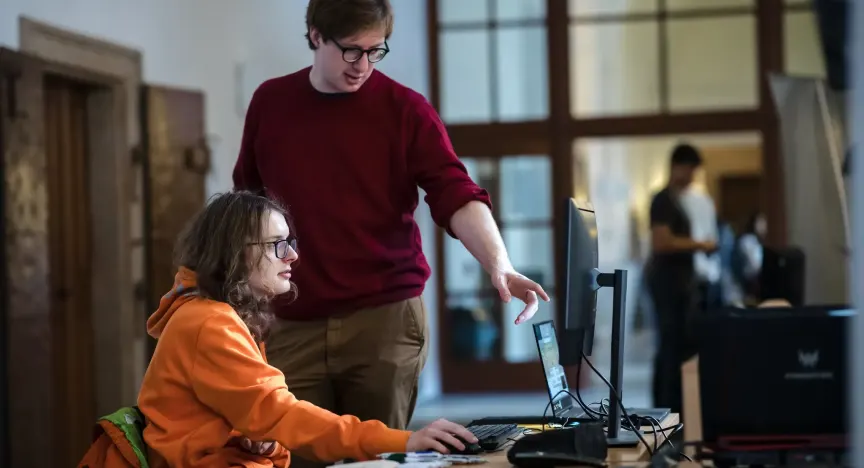Course methodology
10 October 2023
Knowledge

All teachers at the GoStudy training center are native speakers. The educational process is built on the direct method - predominantly not using the students’ native language. From the first lesson only Czech is used.
The purpose of the courses is to develop students' passive language skills (understanding oral and written language) and active skills (reproduction of oral and written language) at level B2 and above.
GoStudy courses are intensive. Students study the language for 5–6 academic hours a day.
The goal is to make the most of the 870 academic hours allocated for the language course, while making the learning process interesting and maintaining students’ desire to learn the Czech language.
Communicative method
Learning through dialogue
First of all, teachers introduce students to the language of everyday communicative situations. Most often, learning is carried out through dialogue, where the teacher acts as an assistant and friend. To ensure that students do not experience difficulties in real communication in Czech, we explain to them how to use the language for various purposes (we teach them to distinguish between formal and informal, oral and written speech) and from the very beginning of training we train conversational skills.
At the first stages, communication skills are developed with a limited lexical and grammatical base, at the last stages - the skills of using the vocabulary learned over the year at level B2 and above.
“My students appreciate the communicative approach to teaching Czech and the fact that we often go on walks and excursions around Prague.” Vladimir Novak (PhDr. Vladimir Novák),
Brainstorming and role-play
Part of the communication method is the so-called brainstorming method. The teacher sets a task, and students share their ideas - simply list everything they think about this topic. The teacher takes on the role of a guide, helps students think in the right direction, comments on all their ideas and gives tips. Such tasks are very effective in mastering vocabulary. The goal of the method is to teach students to quickly respond to questions, not be afraid to speak, and easily express their opinions in Czech. At the same time, grammar and writing skills are practiced here.
Another communicative method beloved by our students is role-play. In order to make the learning process more diverse, our teachers include games in it. These could be board games, bingo, crosswords, dominoes, puzzles, cards, and so on. The goal is to consolidate the grammar and vocabulary learned. Teachers often organize competitions for students and organize work in pairs or groups.
Graphic materials are used to reinforce productive oral and written language skills. GoStudy has a very rich database of educational illustrative materials.
“Working as a teacher is very demanding and challenging, but I really enjoy it. My students say about me that I am incredibly patient :)" Marketa Švehlová (Bc. Markéta Švehlová),
Extracurricular activities
Extracurricular activities play a major role in increasing students’ motivation to learn the Czech language. Therefore, we always organize a lot of trips, excursions, conversation evenings, and trips to cultural events. The goal is to help students begin to actively use the Czech language in everyday life.
Audiovisual and audiolingual methods
We actively use the audiolingual method when practicing phonetic skills. Our teachers use a projector almost every day. We pay a lot of attention to listening tasks, listen to Czech songs, watch fragments of Czech films. We have developed tasks for them aimed at developing productive speech skills. Techniques such as imitation, memorization, and the formation of speech statements by analogy are used.
Only proven methods
In our training center, we have abandoned the use of such modern methods as suggestopedia (the use of musical influence to improve the perception of material) or the act and speak method (learning a language through theatrical performances).
We need our students to become proficient in the Czech language and reach level B2 in a relatively short time, that is, 6–8 months. For this we use proven methods.
“My goal is to teach in such a way that my students are not afraid to speak Czech, go to Czech universities and integrate into Czech society.” Yana Hudečkova (Mgr. Jana Hudečková),
Formation of grammatical competencies
We need our students to master Czech grammar well. The main method of presenting grammar is not always the teacher's explanation. That is, the frontal method is the main one, but we also try to push students to learn to derive grammatical rules themselves. Firstly, this way the rules are better remembered. Secondly, the student learns to understand the Czech language as a system.
Method of teaching critical reading
We prepare students to study at Czech universities, so one of our main goals is to teach them to understand texts. Entrance exams for many areas test applicants’ ability to understand complex texts in their specialty. At the first stages of training, we work with the simplest texts. Here students learn reading strategies in Czech.
Once we learn the basics of grammar, we begin to work with more complex texts. For example, with newspaper articles, popular science texts from various thematic magazines. It is important for students to learn to understand the main ideas of the text.
Teachers perform various types of tasks with students, referring to tests from entrance exams to Czech universities from previous years. This work includes an in-depth study of Czech vocabulary. Students learn to select synonyms and antonyms. The classes develop critical reading skills, the ability to deduce what follows from the text, and determine the author's intentions.
Increased number of hours in phonetics
Because the Slovak accent is very strong, we have increased the number of phonetics hours in our curriculum. When staging Czech pronunciation, audiolingual methods are used. Exercises are performed on the pronunciation of Czech sounds, strengthening the skills of correct stress placement and pronunciation skills of long vowels.
Students undergo intensive phonetic practice in the first week of training. Further, throughout the course, teachers correct incorrect pronunciation in class and further develop students’ phonetic competencies during advisory hours. If necessary, a speech therapist is involved in the learning process.
Keep up to date with all new techniques
All GoStudy teachers are members of the Association of Teachers of Czech as a Foreign Language (AUČCJ).
Our teachers regularly participate and speak at meetings and seminars. As members of the Association, our teachers are aware of new methods, textbooks and projects. At a meeting of the methodological commission of the GoStudy training center, we discuss what new techniques are appropriate to include in the educational process and to what extent.
Testing and monitoring student progress
In the learning process, we highlight separate stages. Intermediate testing of students' knowledge progress is carried out regularly. All teachers create small tests that check how students have mastered certain topics. At intervals of every 100 academic hours, all groups of our students write a comparison test. Throughout the course, teachers assess each student’s language progress and provide individual recommendations.
Each GoStudy teacher has advisory hours. A student can come and ask for an explanation of a topic he does not understand.
If among the students there are children with learning disabilities - dyslexia and dysgraphia, teachers take an individual approach towards them. At the end of the course, each student writes a final test and takes an oral exam. This exam informs students what level of knowledge of the Czech language they have achieved according to the CEFR (Common European Framework of Reference for Languages).
Related articles


